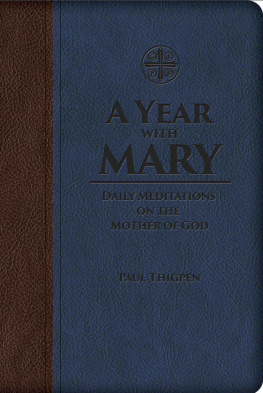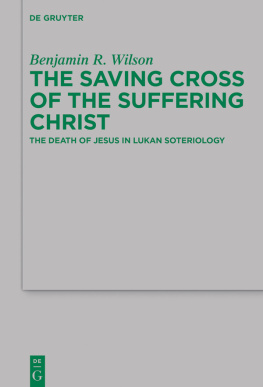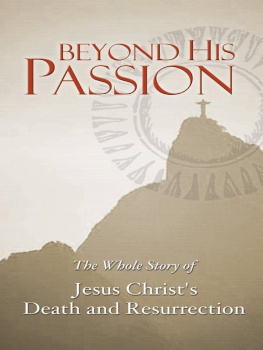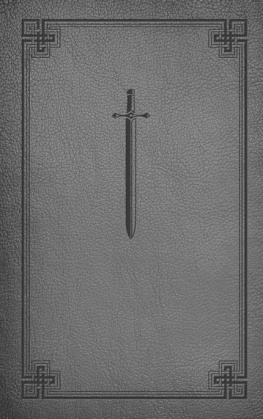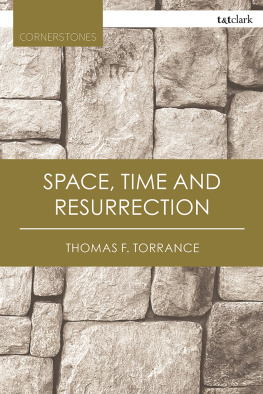Paul Thigpen - The Passion: Reflections on the Suffering and Death of Jesus Christ
Here you can read online Paul Thigpen - The Passion: Reflections on the Suffering and Death of Jesus Christ full text of the book (entire story) in english for free. Download pdf and epub, get meaning, cover and reviews about this ebook. year: 2017, publisher: TAN Books, genre: Religion. Description of the work, (preface) as well as reviews are available. Best literature library LitArk.com created for fans of good reading and offers a wide selection of genres:
Romance novel
Science fiction
Adventure
Detective
Science
History
Home and family
Prose
Art
Politics
Computer
Non-fiction
Religion
Business
Children
Humor
Choose a favorite category and find really read worthwhile books. Enjoy immersion in the world of imagination, feel the emotions of the characters or learn something new for yourself, make an fascinating discovery.

- Book:The Passion: Reflections on the Suffering and Death of Jesus Christ
- Author:
- Publisher:TAN Books
- Genre:
- Year:2017
- Rating:3 / 5
- Favourites:Add to favourites
- Your mark:
- 60
- 1
- 2
- 3
- 4
- 5
The Passion: Reflections on the Suffering and Death of Jesus Christ: summary, description and annotation
We offer to read an annotation, description, summary or preface (depends on what the author of the book "The Passion: Reflections on the Suffering and Death of Jesus Christ" wrote himself). If you haven't found the necessary information about the book — write in the comments, we will try to find it.
Paul Thigpen: author's other books
Who wrote The Passion: Reflections on the Suffering and Death of Jesus Christ? Find out the surname, the name of the author of the book and a list of all author's works by series.
The Passion: Reflections on the Suffering and Death of Jesus Christ — read online for free the complete book (whole text) full work
Below is the text of the book, divided by pages. System saving the place of the last page read, allows you to conveniently read the book "The Passion: Reflections on the Suffering and Death of Jesus Christ" online for free, without having to search again every time where you left off. Put a bookmark, and you can go to the page where you finished reading at any time.
Font size:
Interval:
Bookmark:
PAUL THIGPEN
TAN Books
Charlotte, North Carolina
Copyright 2004 Paul Thigpen
The Passion: Reflections on the Suffering and Death of Jesus Christ was first published in 2004 by Allegiance Press, Fairfax, New Jersey. This TAN edition has been re-typeset in 2016, with some revisions in the text. Typography in the TAN edition is the property of TAN Books and may not be reproduced, in whole or in part, without the written permission of the publisher.
Unless otherwise noted, Scripture quotations are from the Revised Standard Version of the BibleSecond Catholic Edition (Ignatius Edition). Copyright 2006 Division of Christian Education of the National Council of the Churches of Christ in the United States of America. Used by permission. All rights reserved.
Scripture quotations accompanied by an asterisk (*) are translated from the original languages by the author.
Excerpts from the works of Maria de Jesus de Agreda were freely translated, adapted, and abridged by Paul Thigpen from Maria de Jess,, Mystica ciudad de Dios, milagro de su omnipotencia, y abysmo de la gracia (Madrid: Imprenta de la Causa de la V. Madre, 1744).
Excerpts from Anne Catherine Emmerich were freely adapted and abridged by Paul Thigpen from the twentieth-century edition of the English translation of the German original by Clemens Bretano, The Dolorous Passion of Our Lord Jesus Christ According to the Meditations of Anne Catherine Emmerich (New York: Benzinger Brothers, 1904).
Cover image: Crowning with Thorns, c.1622 (oil on canvas), Baburen van, Dirck (c.1595-1624) / Private Collection / Bridgeman Images
Cover design by Caroline Kiser
ISBN: 978-1-5051-0594-0
Published in the United States by
TAN Books
P. O. Box 410487
Charlotte, NC 28241
www.TANBooks.com
Printed and bound in the United States of America
He who desires to go on advancing from virtue
to virtue, from grace to grace, should meditate
continually on the Passion of Jesus There is no
practice more profitable for the entire sanctification of
the soul than the frequent meditation on the sufferings
of Jesus Christ.
St. Bonaventure
For Francesco Mion
Dearest friend, brother, and spiritual son
His Blood Be On Us and On Our Children!
An Introduction
US AND ON OUR
CHILDREN!
M y first crucifix, a gift from my aunt, was made of white plaster, about a foot long. I was rather young, and the novelty of it fascinated me; I had seen such images only from a distance. I examined it carefully, running my fingers over each detail of the wounds, nails, and thorns.
It was beautiful. But before long I concluded that it was much too clean. Pulling out my box of water- colors, I painted it, with bloody reds and purples dominating the whole. All in white, it seemed, the Figure had looked like a ghost. Now, with livid flesh, He looked at last like a Man, if a suffering One.
Since that time, the sacred image of Christ on the Cross has met me and challenged me countless times in church, on the walls at home, and in the homes of friends. Like millions of Christians through the ages, after years of familiarity, I still find myself strangely drawn to the crucifix, to reflect on the agony portrayed there. And the images I find the most honest, I also find the most compelling: I mean the kind of dark, grisly crucifix so beloved in Latin culture, and so unsettling to our own.
Why unsettling? I once heard a religion teacher in a parochial school complain about the crucifix. She insisted that the sight of a dying Human Being on an instrument of torture simply shouldnt be tolerated in a school or even a church. Too negative, she said, too messy, too bloody, too disturbing. Think of the children!
I do think of the children. And when I do, I also think of the broken, bloody world they inhabit, the same world into which their Savior came as a Child, the same world that nailed Him to that Cross. I remember that they were born in blood, they may well die in blood, and in the meantime, they will no doubt see a great deal more of blood.
The question is not whether our children, and we ourselves, will be confronted with blood. Life itself is crimson-stained. The question is this: What kind of meaning will we find in the blood? Will we learn that life is in the blood (Leviticus 17:11)? Will we know that forgiveness, healing, and grace are in the blood? Or will we believe the lies of our time that blood is a mere commodity, cheap entertainment, or the never-quite-satisfied taste of revenge?
The crucifix has much to teach us about the true meaning of blood, if we will only pay attention. A great deal of traditional Christian prayer and meditation has been precisely the attempt to pay that kind of attention. Such prayer dwells on the passion of Jesus Christ as prophesied and foreshadowed in the Old Testament; preached and remembered in the four Gospels; interpreted and lived in the rest of the New Testament.
THE POWER OF THE PASSION
The Passion is an immense thing, a supernatural and divine thing, and thus a dangerous thing. Understood, appreciated, and embraced for its own sakegenuinely, if never fullyit has the power to overthrow us and, overthrowing, to save us. Misunderstood, dismissed, or manipulated for a diabolical agenda, it still has the power to overthrow us and, overthrowing, to damn us.
The history of the Church provides ample illustrations of both kinds of encounter with the Passion. The Apostle Paul so deeply entered its depths that he bore on his body the marks of Jesus (Galatians 6:17). Yet he also wrote in tears of those he called enemies of the cross of Christ (Philippians 3:17)Christians who confused and abused the message of Christs suffering, death, and resurrection.
The horrible pogroms against Jews across the centuries display perhaps most starkly the hellish outcome when people attempt to harness the power of the Passion for selfish causes. Some Christians heard the sacred story and twisted it into a summons to vengeance against the Christ killers, refusing to recognize that they had to include themselves in that wretched category. For them, the blood of Christ was not a costly and humbling invitation to goodness, but rather a convenient and explosive excuse for evil.
Nevertheless, there were men and women in every generation who hid themselves deeply in the precious wounds of Jesus and found there the bloody womb for a new birth. The Spanish Franciscan Maria (Coronel) of Agreda and the German Augustinian Anne Catherine Emmerich were two such Christians. Excerpts from Scripture and from the works of these two women form the basis for the forty reflections on Our Lords passion presented here.
MARIA OF AGREDA (16021665)
Maria Coronel entered the convent in Agreda, Castile, as a teenager, and took the name Maria de Jesus. By the age of twenty-fiveover her protestsshe was made abbess and, except for three years, remained the superior there for the rest of her life. During the time of her administration, the convent became one of the most fervent in all Spain, and she died with a reputation for great holiness. The cause for her canonization was introduced in 1762 by the Congregation of Rites at the request of the Court of Spain.
Maria is chiefly known, however, for writing a book entitled The Mystical City of God: A Divine History of the Virgin Mother of God. Though the text focuses on the life of Mary, her life is intimately intertwined with that of her Son. So the volume in part attempts to take us up close to the events of Our Lords passion.
The Mystical City
Font size:
Interval:
Bookmark:
Similar books «The Passion: Reflections on the Suffering and Death of Jesus Christ»
Look at similar books to The Passion: Reflections on the Suffering and Death of Jesus Christ. We have selected literature similar in name and meaning in the hope of providing readers with more options to find new, interesting, not yet read works.
Discussion, reviews of the book The Passion: Reflections on the Suffering and Death of Jesus Christ and just readers' own opinions. Leave your comments, write what you think about the work, its meaning or the main characters. Specify what exactly you liked and what you didn't like, and why you think so.

